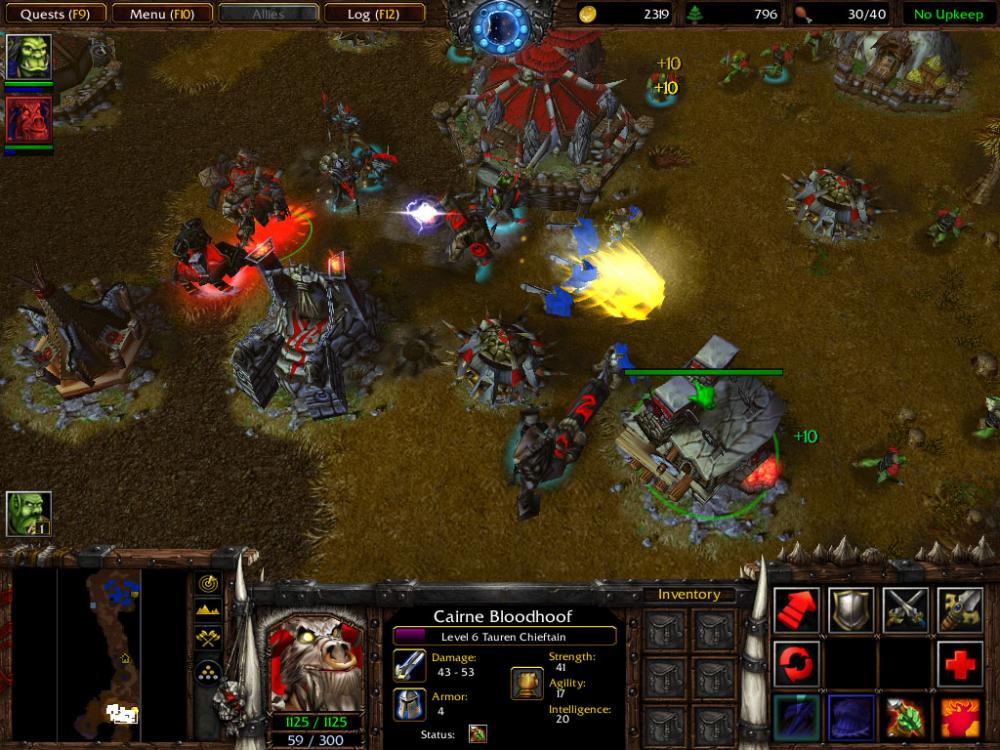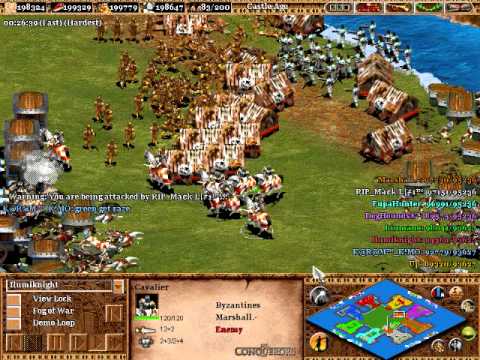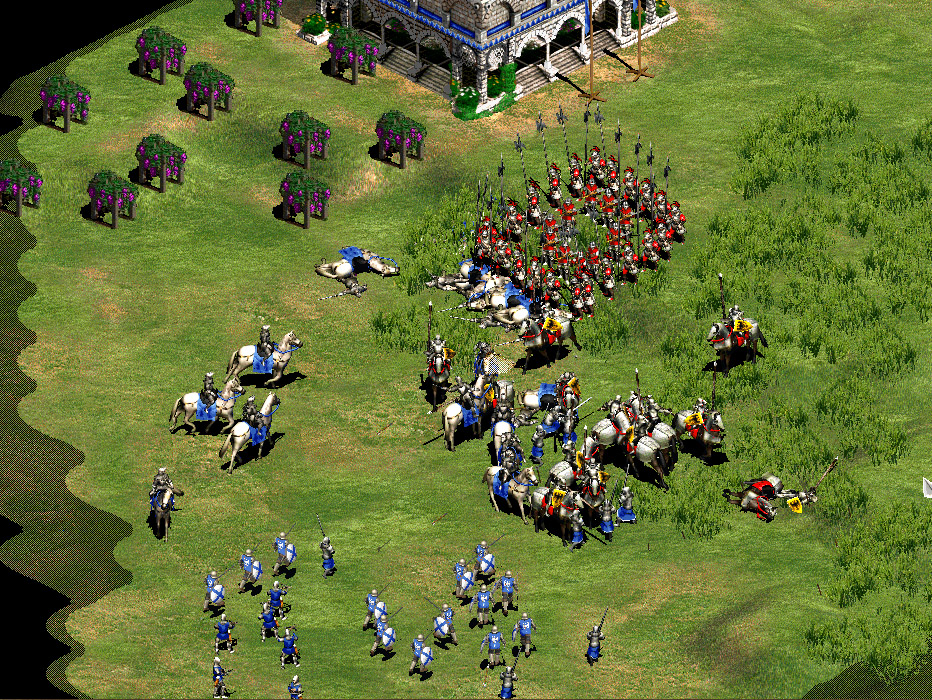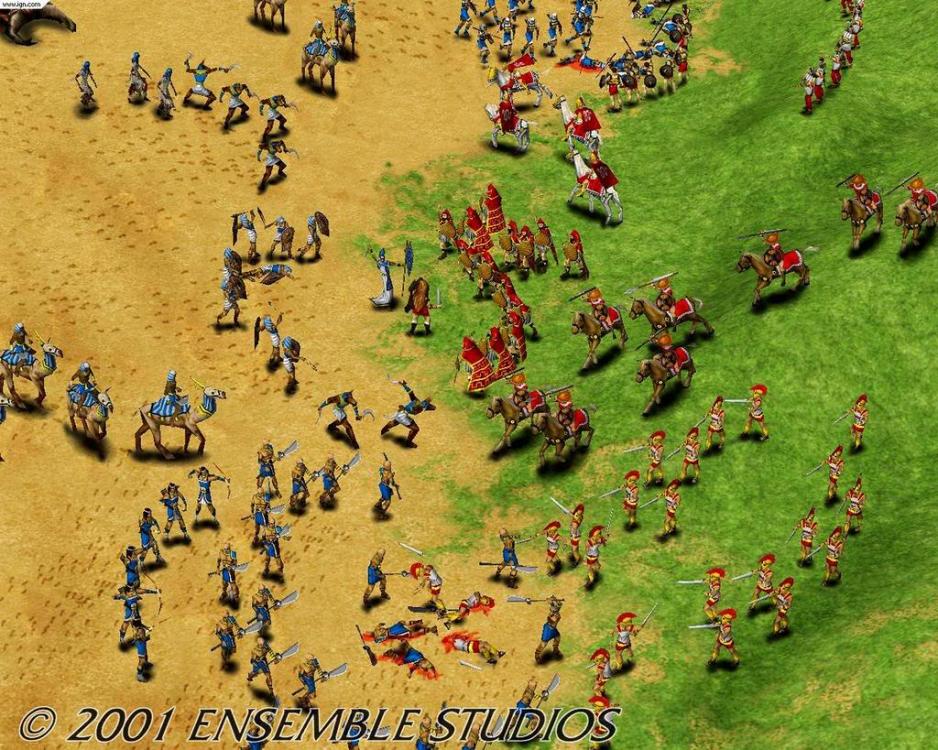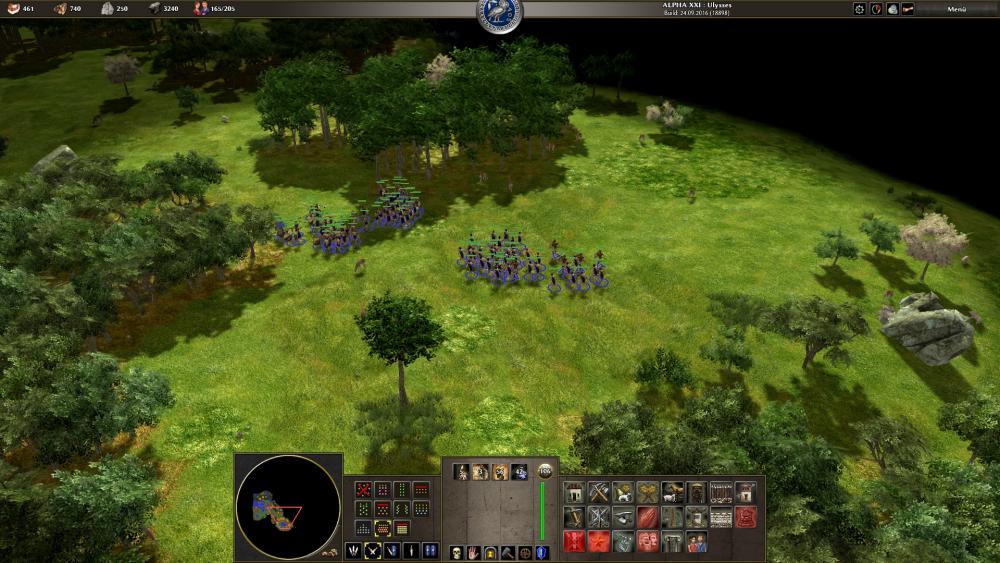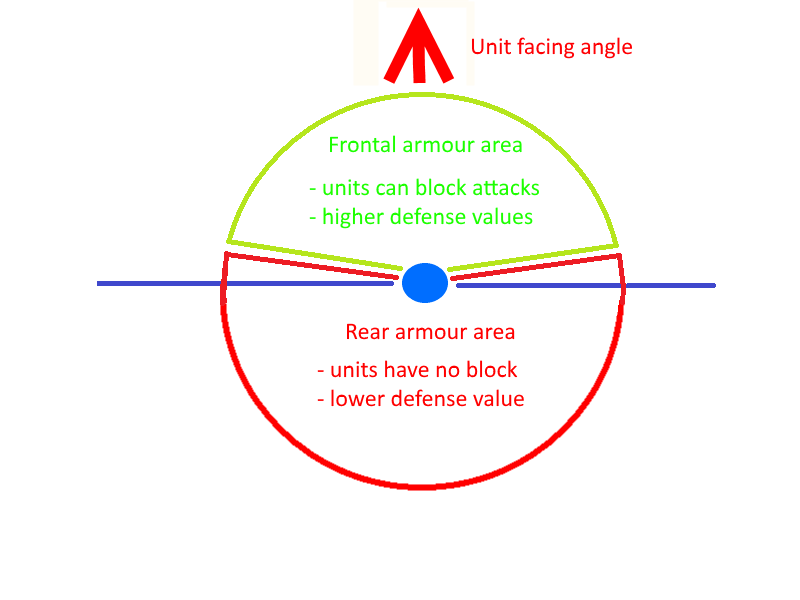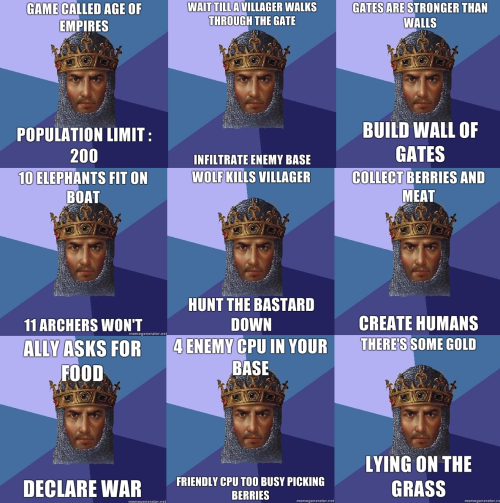Leaderboard
Popular Content
Showing content with the highest reputation on 2017-04-13 in all areas
-
That's entirely dependent on what type of game you are playing/making. I do agree that it's most likely not a good idea for an AoE-like RTS though.3 points
-
@DarcReaver: please mind your tone a little bit, will you? @Lion.Kanzen: if the only change would be to remove the CS concept than it would indeed be even more a AoK clone. However, combined with the other changes mentioned in this thread I think it plays quite differently2 points
-
Hahahaha, always answer the same. is because the realism of the epoch. Only needs some extra stuff and you can convert your peasants in soldiers. Mostly of people that are new , are confused the first time. But with the time, the concept work from early, and in late phase you can mix soldiers with champions. Few soldiers are working. you can't expect all soldiers were medieval or modern full service professional with a commander in the battalion marching to the war. Confess you want a classic game with few personal preferences. for example if they removed SC this game becomes more to be a AOK clone. We can have a mode where soldiers only fights. why not? You still angry? Why don't search a conciliation by both sides?2 points
-
Something that Danny and my ideas share is tying technological progress to physical structures on the map that can be destroyed and thus the technological progress lost. This seems like an avenue worth exploring whether pro-phase or anti-phase.2 points
-
This discussion highlights everything that is bad about phases. Look at the posts endorsing phases, they are all about ways to restrict the player, and arbitrary ways to categorize things into phases. I understand that this is a game and things have to be simplified, and I appreciate the efforts of people to try and improve upon existing ideas (this is in fact more important than new ideas!), but I really think phases/epoch/ages have always been a dead duck in RTS games. A city/civilisation is something that evolves gradually, it does not jump from one age to the next, there is no reason why we cannot have this authentic feeling, there is no real reason to limit the game to distinct phases other than to emulate games that came before. I edited this part out because I went on a rant about how phases make no sense and seem to be completely detached from the game world, but I have deleted that and instead I will try to provide some alternative ideas. Knowledge as a Resource I want technology to be something tangible in the world, not a flowchart disconnected from the rest of the game. I will start by describing a basic settlement and how knowledge is accrued and used by primitive cultures. Each working citizen will accrue a trickle of knowledge while they work (this simulates the natural tendency to innovate and find more efficient ways to complete tasks). For every working citizen, the science score of the civilisation is increased by a small amount; the science score affects the rate at which knowledge is acquired over time. Advanced buildings and units require knowledge to build, however, knowledge is not spent like other resources, but also unlike other resources it must be maintained. The population itself is the basic and most vital store of knowledge, if your population collapses then your technology will disappear along with it! Libraries (as separate buildings or contained within other buildings, e.g. Universities) greatly bolster the civilisation's knowledge base. Buildings such as the Temple, Library, University and Observatory* are places that provide huge boosts to the science score and thus the rate of knowledge acquisition. So knowledge is not a static resource, it is not something that can be simply piled up but can change greatly depending on these factors of population size, libraries and science score. (For the more mathematically-minded amongst us I have attached an image of an equation that produces the desired relationship.) What this means in terms of gameplay is that knowledge (and thus technology) are bound to tangible objects and people that must be protected. * The effectiveness of the observatory depends on its elevation, being more effective on higher ground, like in real life. Technology Buffs & Building Upgrades Technologies like efficiency boosts would either be unlocked automatically past a certain knowledge threshold, or require a new building to be constructed (which would be unlocked by passing a knowledge threshold). You would not pay to unlock technologies as before; all technologies must be linked to either a specific building or the overall knowledge score (and ultimately the population of course). So technologies would be fluid just like knowledge. My thoughts on building upgrades is that they should be very limited if existing at all. Why? From both an aesthetic and gameplay point of view it seems a bit of a spoiler to simply click on a building and upgrade it. Instead, what is far more natural is to build new buildings alongside the old, or to demolish the old to make way for the new. In real-life cities, the mixture of architecture styles tells you something about the history of the city. I would love this to be a part of 0AD, being able to see how a city has evolved over time; you could look at a city and maybe you will see a clear divide between the old city and the new city as it has expanded over time, or perhaps the outskirts are littered with ruins from an ancient war or perhaps the ruins are simply old buildings that were demolished to reclaim building materials. I am getting carried away with this idea that would require tonnes of new art! Should Other Resources Be Volatile? I think so, yes. So you have 10 000 stone? What if I need stone, why can I not raid your base and steal your stone? Why can I not burn down your granaries so that your people starve? Resources are what most wars are fought over so why is this not the case in 0AD? I think I will have to learn this level of programming because I always have these grand ideas and then I sit around and wait and hope that somebody else makes them!2 points
-
2 points
-
I don't get this ant size unit argument at all, formations are an integral piece of the puzzle that hasn't been fully fleshed out yet. Formations aren't fully implemented so units stay in formation during battle. 0 A.D. harkens back to the CnC and AoE/AoM way of doing things, with the twist of historically accurate citizen-soldiers and formations add into the mix. Healing may need some work, but the temple and healer dynamic is sound. Perhaps you are right about the training times being too fast, and things like making farms require farmsteads are good ideas, but other than that I just don't see most of the problems you see.2 points
-
I have read various opinions on this topic like 1. Metal and stone usually are placed directly next to the CC. It should be more risky to mine them and therefore they should be placed farther away. I agree, my suggestion actually is to encourage more risky gathering, but still provide the opportunity to gather savely in the base which will be punished by other means. 2. Balancing of food resources like fishing for villagers (is not really possible at the moment due to some citizen gather range / size of fish resource incompatibiltiy I think), fish and berry regeneration (don't actually know why it wasn't implemented - I guess some disagreement on design?) or making hunting more viable and nerf/change fields (also discussed, but again disagreement on design I think). I agree especially with the fields: they shouldn't give an infinite supply (and a reseeding queue really doesn't require that much work like in AoE2 if we allow batch "training" like for units - alternatively we could give the option to reseed automatically as long as there are enough resources). And till this day I really haven't understood why on earth something should grow on a field if you throw some wood on it. As seeds are no resource, I would say fields wouldn't require any costs except for a relatively long build time (perhaps 1.5-2.0 times longer than now) and some shorter reseeding time. This would also encourage hunting in the early game as building a field would be really demanding. I would also like to make field efficiency depend on the ground texture (buff on green and fertile ground and debuff/prohibition on desert, stony, snowy/icy ground). This would make decisions about building placement more interesting. I think Stronghold Crusader did this very well and this was also a reason why this game has been the most popular of the entire Stronghold series. Ok this is a interesting topic, but I won't focus on this further at least for now. 3. I think I once read a ticket about the option to make the amount of resources adjustable in the game setup. E.g. on "low" a tree provides 100 wood, on "medium" 200 wood and on "high" 400 wood. Sadly I couldn't find it again (still need to look at older tickets). If I remember right already some work has been done for it which should be finished and included in the main game because it's a great idea IMO (at least for non-professional / non-ranked games). A bit off-topic, but still affecting resources gathering: 4. Actually same thing as with the fields: why do I need wood to construct some stone buildings??? IMO building costs should be (more) civ-specific, e.g. greeks, persians, seleucids, carthaginians, seleucids, iberians and romans would have a high demand of stone whereas the celtic tribes and perhaps mauryans would use more wood for most of their buildings. The exact costs would actually depend on the current model used for the building. Of course this would need a lot of balancing, but I'm sure this can be done and adds to the uniqueness of the factions and thus leads to a better gameplay experience. Probably stone slabs would need to provide a bit more resources to fit this increased demand. Even more off-topic, but interesting: 5. Make trader garrisoning more viable, see http://trac.wildfiregames.com/ticket/3428. Actually trading is an extra topic, but I just want to raise some attention for this problem which is quite obvious, but still nobody seems to care about it. 6. "Mod for modders" to add/remove resources easily to/from the game. https://github.com/0ADMods/resource_agnostic I think it may be considered to include this mod into the main game (if it's finished?). Not because we need it but just for better modding support. 7. Starting resources vs. max population display in the game setup: either we should use numbers for both (e.g. resources: "300", population: "200") or descriptions for both (e.g. resources: "medium", population: "high"). Just for consistency. ---------------------------------------------------------------------------------------------------------------------------------------------------------------- Thinking about point 1, some additional ideas came to my mind. Apart from treasures, we actually have a relatively huge variety of food sources (fish, fields, hunting, berries) and trees (different kinds of trees and also size, e.g. baobab gives more and some "wood bushes" give less). In contrast, you can just mine one kind of generic metal and one kind of generic stone. At least for stone there are also ruins and pyramids and I think it's OK if the stone mines just fit to the current environment as they do now (they somehow represent different kinds of stone). Still it would be nice to give them some specific names like "sandstone" for desert, "marble" on mediterranean maps, and so forth. That's not a big deal actually. Edit: IT SEEMS I CONFUSED SOME PEOPLE WHO THINK I WANT TO INTRODUCE NEW RESOURCES. THIS IS NOT THE CASE. I JUST WANT DIFFERENT SOURCES FOR THE SAME METAL WE USE NOW. Have a look at my mod. Now, the intersting part is about metals. Metals have very different properties (much more variety as stone - if you speak about chemical composition it may be the other way round, but I mean the macro scale). They can be very rare, heavy and noble like gold or quite light, abundant and reactive like aluminium (though it wasn't possible to extract pure aluminium at those days). They can be even poisonous like mercury to a higher or led to a lesser extent. So all in all I think we should somehow represent that variety in-game even if we stick to generic metal as a resource (like we have differerent food sources, but one food re-source). My suggestion is to differentiate between gold, copper and iron sources/ores, at least by giving the existing ores appropriate textures. This would actually be the chance to introduce some advantages and disadvantages of the ores and thus add some strategic depth. My ticket http://trac.wildfiregames.com/ticket/3635 gives a bit more detailed description of what I think. In a nutshell: you should have to decide if you want to slowly and safely mine iron, which is quite abundant also next to the CC, but quite inefficient OR if you want to expand your territory towards risky places with gold deposits which can give you a strong advantage in metal gathering if you are able to defend your gatherers against attacks and distractions. For existing maps we could either exchange existing metal ores with copper (which should fill the gap in between gold and iron) or leave the generic metal ore as it is and use the new ores only in new scenarios/maps. Extra: there are templates for small metal ores, but I can't remember to have them found once on a map. At least in Atlas you can create them - the textures are not always fitting to the big ores. Is that the reason? So what to do? As historic_bruno said it's best to do a small mineral mod for this. More or less I have only modified templates so far and do not have that deep programming skills. However, I would give it a try. If the whole thing works I would probably need some guy for making textures (new meshes would be even better) because I'm not experienced with this topic either. Thanks for reading, I would be glad to hear some opinions about my points (numbers are roughly priority) It would be also be helpful to collect more links to the tickets refering to one or more of these topics.1 point
-
Resource & economy System revised This concept only covers economic features of civs. Military will be covered in a separate topic to keep this thing small. Some aspects of economy of course affect military as you’ll see later, but this is not the main argument at the moment. Military design and economic design will be tweaked to fit each other for every civ type. At first: I’d suggest to pair civilizations into groups (i.e. Hellenic Civs, Nordic civs, Indian/African civs and so on). I’ve covered Gauls, Britons, Iberians, Spartans, Athenians and Seleucids so far as more-or-less specific layouts. This again is not a 100% finished layout with every detail covered. Instead it's a general guideline to differ civs from each other and allow to create unique game play patterns for each of them. More than they currently are. The other civs will come later as I need to create something unique for them aswell. I’ll expand this concept for them in the next update(s). A .pdf is attached to be bottom of this post. (edit: I rewrote some parts because they contained some spelling errors. Should be more readable now) I. General thoughts on resources Every strategy game requires resources. The resources have to fit the game and players should have a choice whether collecting which resource is more important to them (strategic diversity). Each resource needs to fulfil a certain “role” that gathering it accomplishes it. To prevent “overburdening” the game with resources there has to be a flow in the game to naturally lead players towards gathering new resources (i.e. a progression from resource A into resource A+B into resource B etc.). Resources that already are gathered by players may not become redundant (because it’s replaced by another resource). If this is done well the economy management doesn’t become boring or unhealthy for the game and allows interesting, different types of playstyles where players decide how they are going to prioritize their gathering and army setups. Citizen/cavalry gatherers removed Yes I know this is a drastic change from the current concept. Yes, it will require reworking parts of the game. However, this is also the opportunity to improve the overall gameplay quality. Advantages of Citizen Soldiers/gatherers: - Usage of military units when not in combat - Especially cavalry can gather far away by hunting - Easy transition from economy to fighting Disadvantages of Citizen soldiers/gatherers: - No distinction between economic and military units (an integral part of every RTS) - Since many gatherers can be active at the same time (economic + every military) gathering rates have to be poor to avoid “economy explosions” which means that the resource income increases exponentially with each additional soldier - Players loose resources when attacking, short math example: o Soldier collects 0.5 food per second, 30 soldiers work as gatherers which means 15 food/second income (or 900 food/minute). Now if the 30 soldiers move to the enemy the player will lose 900 food every minute from his soldiers not gathering. Provided that the enemy has a similar army/economy that means that he’ll be ahead with 900 food for each minute he can gather (which would be equal to ~10 or more soldiers). o The attacking player needs to destroy more than 900 units worth of food every minute to get an advantage from his attack. If he can’t do that his attack actually weakens the Attacker instead of the Attacked -> unbalanced by design o Fixes: soldiers move at unrealistic ultra high speed (less time to get to the enemy) or lowering the gathering rates. The issue is the same still, attacking player initially has a large disadvantage - There is no progress from weakest -> strongest unit. Instead the players already start at a high level and then only progress in very small steps towards higher tech levels - Citizen soldiers discourage capturing as they are efficient at protecting the base early on, rendering capture rather useless - To get citizens back to work is a very fiddly task and annoying compared to regular economic units Overall it’s better to adjust gathering to specialized units for each civ type instead of giving every civ the ability for soldier gathering. This makes civs more diverse (-> more gameplay depth). One (poor) game mechanic lost for a massive gain in playability is more than worth it. Building layout (general) 1. Civic Centers are buildable from the start. City influence radius reduced. Can train a weak “militia type” unit and slingers. Slingers can be used to help hunting and Militias are weak units that can be used to harass and defend. Both units hard counter each other (slinger > militia, but in close combat militia beats slinger because of much lower hitpoints) 2. Storehouses, Sitobolon structures buildable in neutral territory 3. Farms require neutral territory, affected by gathering duration (fertility) – fields initially generate resources very slowly, but the rate increases the longer it is harvested by gatherers. When the gathering stops the field fertility decreases. To-do: Generate map areas in which farms are more productive (a possible map control element) 4. Military structures are postponed to City Phase, units are split up and not available all at once – either by per-building upgrades (only coding required, could be a workaround) or by splitting up the buildings into classes – Barracks, Stable, Archery range type classes (requires artworks), depending on civ type. Gatherer Limits: Food: 2/4 (for small/large food sources) Wood: 3 (for all trees) Stone, Iron, Silver: 3/5 (like food) Food – basic resource. Used for training units, upgrades (military), melee infantry & slingers, City advancing Wood basic resource. Used for military training (support/ranged units, ships). Used for economic upgrades, use for low tier buildings Stone – resource that constructs high tier buildings and expansions (civic centers, barracks, temples, gymnasion etc.) Iron - basic military resource, all basic melee military units require metal (swordsmen, pikes and cavalry). Silver - advanced military resource - is important for military improvement techs and used for training superiors, elite units. Slow to gather. Population - instead of being only connected to houses, population is influenced by city size (village - town - metropolis). Required to train units (obviously) Population cap (thoughts) Houses are hardcapped at ~10 houses per city. Depending on city level they can provide 10-20-30 population each. Alternatively: Military requires no population and is only depending on the food that is available from gatherers. Gatherers require population from houses and are hard capped per city. In a logical sense, soldiers that are at war do not sleep in houses, so it's rather strange that they take up pop from the city houses. Instead, armies rely on being supplied with food, water, weapons etc. from their home cities. This concept could be further elaborated, as I think it would fit the city Advance system. Alternatively, each city grants a fixed amount of population. Houses then are scrapped. I'd keep houses for the sake of being authentic though. houses belong into cities. Upgrade System Phase advancing: Food and Stone Economic upgrades: Lumber and Iron Military unit unlocks: Food/Lumber & Iron (ranged and melee units) Military unit type upgrades: Food and Silver Blacksmith “System“ Blacksmiths automatically reduce army Iron costs and increase the training speed for Sword wielding units. It can further research Metallurgy type techs that allow faster training, and allow further, cheaper unit production. Upgrades are not tied to City Phases anymore. Concept: Blacksmith generates “experience ranks” over time which allows more advanced upgrades to be researched. Corrals Can garrison captured herdables to provide food over time. Idea taken from the "intended" version of 0AD which isn't finalized yet. Gameplay reasoning There should be a transition from one type of resource to others, similar to this: food -> wood -> metal -> stone/silver. Players are not overly confused with gathering many resources from the start. As the game progresses the economy complexity increases. Early civic center expansion allows to take additional gathering spots and economic advances. Gatherers training times can be increased since it's possible to train them in multiple buildings. Since gathering spots are limited there has to be economic expansion to fit all gatherers to the spots. Phase advances that require stone - this way, players automatically need to gather a resource that will be more important in city phase, i.e. to build Phase II buildings. Military unit upgrades (like “advanced training” or unlocking certain units) create a resource transition towards Silver. II. Hellenic Factions (Sparta, Athen, Seleucids) Economic concept: Hellenes are defensive civs, and thus have bonuses for foraging berries and decent farming. Gathering rates are comparably high, so they can exhaust their own resources more quickly. Slaves are free gatherers that can be trained, have a hardcap that can be increased with City Phases and Slavery Techs. Athen speciality: silver mines last 20% longer Sparta speciality: slaves have 10% faster gathering rates, hoplites 15% faster, start at veteran rank Seleucid speciality: farming rate +50% (rate at which farming productivity increases) Gatherer types: Women (50 food, 1 pop) Gather rates: food Hunt : 1.25 herdables : 1.25 berries : 1.50 grain : 0.80 Gather rates: wood Trees: 0.6 rubble trees: 1.2 Gather rates: stone Quarries: 0.4 rubble stones: 0.8 Gather rates: iron Iron mines: 0.3 ambient iron: 0.6 Gather Rates: silver Silver mine: 0.2 Slaves (no cost, no pop. Have a hardcap) Gather rates: food Hunt : 1.4 herdables : 1.25 berries : 1.00 grain : 1.00 Gather rates: wood Trees: 0.8 rubble trees: 1.2 Gather rates: stone Quarries: 0.8 rubble stones: 1.2 Gather rates: iron Iron mines: 0.6 ambient iron: 1.2 Gather Rates: silver Silver mine: 0.4 A second type of gatherer that excels at mining. There are 2 options for them to be limited: either they automatically start to loose health if there are too many at one place, or they are simply hardcapped by default. It would be interesting to utilize capturing features to increase the maximum slave count. I.e. for 5 wounded/killed soldiers on the battlefield the number of slaves trainable increases by 1. So, by slaying enemy units the economic power rises for Hellenic civs. Due to the amount of gatherers per resource spot, having hundreds of slaves isn’t profitable as there is a need for more gathering spots to collect resources from. Buildings: Economic: wood only Military: wood and stone Civic: stone and food Iron: none Silver: none III. “Alpine” Civilizations (Iberians, Gauls, Britons) Economic concept: Opposed to Hellenes civs “nordic” civs rely more on hunting. They are mainly offensive civs to start with. Their buildings do not require much stone (if at all) but are less sturdy. Gathering rates are lower for farming and mining stone. The treadmill can be used to increase farming at a later civ stage to bring them on par with other civ’s lategame food economy. Early huntables creates power spikes because they can advance quickly and field armies in a shorter period of time. Also, this allows more spreading and early expansion. While Hellenes need to consider how many cities they can supply and defend, the Nordic civs can play a rather mobile earlygame with rushes and lots of interaction with gaia. Civ special advantages: villagers and Hunters receive weapon upgrades from the Blacksmith. Iberian speciality: Start with additional metal, soldiers have 20% bonus speed, iron gathering +15% Gauls speciality: +50% bonus damage against animals, units that are hunting have higher accuracy Cavalry +20% faster Britons speciality: Gathering from herdables +50%, herdables in stables provide more food Villager (50 food, 1 pop) Gather rates: food Hunt : 1.5 herdables : 1.5 berries : 1.0 grain : 0.60 Gather rates: wood Trees: 0.7 rubble trees: 1.2 Gather rates: stone Quarries: 0.2 rubble stones: 0.6 Gather rates: iron Iron mines: 0.4 ambient iron: 0.8 Gather Rates: silver Silver mine: 0.2 Villagers are both male and female. They can utilize spears or bows for hunting. Melee defense with knifes/swords. Hunter (80 food, 40 wood, 1 pop) Gather rates: food Hunt : 2.5 herdables : 2.25 berries : 1.50 grain : 0.80 Gather rates: wood Trees: 0.6 rubble trees: 1.2 Gather rates: stone Quarries: 0.4 rubble stones: 0.8 Gather rates: iron Iron mines: 0.3 ambient iron: 0.6 Gather Rates: silver Silver mine: 0.2 Hunters are mounted gatherers that can move swiftly around. They attack with spears and with upgrades/veterancy level they perform as a skilled mounted skirmisher unit. They can harass from the start, but due to a low attack rate with miss chance they are not that good to hit moving gatherers. As they kill animals their rank increases and they become more effective at raiding enemy economic units. Buildings: Economic: wood only Military: wood only Civic: wood and food (!) Iron: none Silver: none edit: removed-Special building : Corrals IV. Map control elements The game should be dynamic. Players should have options for economic expansion and there should be fluent progress on the whole map, with increasing intensity towards mid and lategame. Many current RTS games revolve around a central “base” from which all major actions are taken. Units trained, teching accomplished, resources gathered etc. Outposts or second bases have less priority because the risk – reward ratio (hard to defend, little benefits in return) is high. For 0 AD I’d like to propose a concept of “fluent expansion”. Since this game features unique aspects – city borders, city phases and a default capturing system for every military unit it would be beneficial to actually concentrate on these aspects. To further emphasize the city progression and the construction of an empire, it’s important to have interaction with the map. Constructing outposts – new cities – that can supply the Capital city to grow in prosperity and power should be a vital part for the course of the game. However, to avoid common issues from other RTS – economic expansion is punished hard by early rushes. Since eco management is pretty basic in many games, not punishing early economic expansion would lead to massive unitspam and create war of attrition, so it’s not desirable. Sort of basic and not very unique. Every game does that. 0 AD features a detailed economy, and so the early focus should actually be economic expansion. Only very basic military available that allows players to focus on where to expand, which positions are worth to create new cities etc. And then, as the game progresses, players can start gathering armies and start fighting. Many players enjoy “no rush” gametypes in which they can actually “build up” before the fighting starts – so rushing, even though it’s common in many RTS, is not the prime and sole option to solve games. By delaying military there is the option for players to satisfy their desire to “build” and then allows a fluent progression into fighting the enemy. How to achieve? 1. Allow military to interact with the map instead with the enemy only. By providing neutral targets that can be captured (like neutral Villages, cities, mercenary posts, slave posts, markets etc.) that can provide military and economic bonuses on a long term by increasing the player’s influence. 2. Allow military to attack positions apart from the main city. By providing multiple possible targets the strategical aspect becomes important – where to attack with how many units, fake attacks to disrupt the player, parallel harassment with multiple small armies which rewards multitasking, etc. 3. Distribution of map resources and hardcapping gatherers to force expansions. If players are forced to explore the map and expand to gain more resources it’s important to know and anticipate where and when the enemy is likely to expand. Game experience and strategical “what if” thinking and decision making is fun and rewarding. Ideas: Easiest: captureable herdables that can be used for food. Slave posts: automatically unlock the option to build slaves in cities for a silver cost. Mercenary post: train map type specific military units that provide additional tactical options in army compositions, instant and at a higher cost. Neutral cities: a small settlement or city with gatherable resources nearby, like a small gaul village, protected by some soldiers and has a couple of houses, maybe some farms. Can either be captured (expansion) or burned down to get immediate resource boost (food, iron, wood) Temples: neutral buildings that generate silver, or allow to train special types of support units that otherwise would only be available to certain civs (similar to a merc camp for non-combat units) Mines: generate iron indefinitely and work similar to farms How the actual implementation and which bonuses are provided is a secondary task. As long as the neutral building creates the urge for players to explore and expand it’s all fine. I’m open for additional ideas for neutral buildings for sure. 0ad Resource1.1.pdf1 point
-
Here's to another one of my random "we should remove features" ramblings. I will in this post argue for removing phases from the game entirely. Let's begin with "why phases are broken". Why phases are broken. It's really quite simple. We have 3 phases. They simply are not different enough. The second phase brings the market, the blacksmith, new CCs, and some towers which you can't really use for offensive purposes. The third basically brings fortresses. And it feels like we could just make fortresses way more expensive and have the same effect. There's not a lot of strategical finesse either: rushing isn't reliant on phases, and any other strategy is going to involve champions which means fortresses. Town phase is sort of an awkward in-between, necessary but never "enough". You really don't want to stay in town phase. Why is this worse than in other RTS? Well for one thing phases don't really make sense as they did in say AoE or RoN, where they represented huge technological advances, so you could completely upgrade units and stuff. In 0 A.D., the idea is that you're simply… having a bigger town, I guess? We don't really "unlock" that much nor upgrade our units a ton, so it all feels very forced and not really that useful. As I said, you just want fortresses, there's really no reason to stay in town phase. It's no castle age or anything. Another oddity is that they really aren't that costly compared to units and buildings. Particularly since the in-game economy tends to be super easy to boom, you quickly end up with fortress age being limited by the speed at which you build the required buildings (which can be somewhat big as you hardly need them in town phase), not by ressources. So what do we replace them with? That's of course the more difficult question. We don't want to go back to earlier alphas where the winning strategy was just to make a fortress straight-away. I see one course of action: upgrading buildings manually. You'd start with a small town council, upgradable in a town center then a town hall or something. Each time, you unlock better techs and abilities (say, batch-creating villagers, more citizen soldiers…). But those upgrades are quite costly. Same with the blacksmith. Barracks. Temple? Whatever we can think of, really. The idea is also that the top buildings, techs, and upgrades should be more costly and tied together. Can't build fortresses until eg you have upgraded your town hall enough (sorta simulating phases but differently) or you have enough barracks, or you have unlocked some tech, or you can straight away but they're sorta weak and useless until you pour more ressources in, and champions have a super long build time until you research tech. But why? This would have several adantages: it makes it way easier to diversify strategies. Want to focus on champions straight away? Well it's going to cost you a ton of ressources but if you do it properly and the opponent doesn't scout you it's game over for him. Want to trade right away? Doable. Basically it allows going way crazier. Individual upgrades of buildings also give more info on what your strategy is (particularly if we go with specialization, such as for example allowing a barracks to specialize in ranged or cav units), so that properly countering your opponent's strategy becomes more reliant on scouting. Overall I think this would be a positive change for the game, making gameplay both more unpredictable and more strategic, while also removing a completely artificial system in favor of something that makes a little more sense. The biggest drawback would be of course multiplying our art substantially.1 point
-
Yea, put seasons in an RTS. And let's rename the game to "Farming Simulator 0 - AD" while we're at it.1 point
-
4 resources - AOE II ripoff city phases - AOE II ripoff Blacksmith/technology system - AOE II ripoff "counter" system - AOE II ripoff Combined with a @#$% game pace. But yeah, using a squad based system is a ripoff... So what? IT's not about whether the system was used by another game at point X in the past. It's about creating a concept, using various tools to make the whole game itself unique. Currently 0 ad has what absolutely, unique and OUTSTANDING gameplay element? Ah yea, soldiers can gather resources.. wooooooooooooooooooooooooooooooooooooooooooooooooooooooow So units can do the most boring task in the game to not be idle. Impressive.1 point
-
You can clearly see following facts: a ) color BLUE units are not color RED's units b ) units from BLUE are clearly not the same as RED c ) there are units with huge axes/hammers/logs that obviously attack close range, while BLUE's units seem to have rifles or something similar And no, my examples are not based on good micro. And you're still not understanding the difference. If you don't use formations is obviusly you don't. You can do that in 0 A.D to form units but you are using the examples at your own convenience.1 point
-
You can clearly see following facts: a ) color BLUE units are not color RED's units b ) units from BLUE are clearly not the same as RED c ) there are units with huge axes/hammers/logs that obviously attack close range, while BLUE's units seem to have rifles or something similar And no, my examples are not based on good micro. And you're still not understanding the difference. Once more: Compared to this: Edit @ the picture - so, there are ~ 200 dead cavarly bodies and long bows + some priests. Even if I have not zoomed in I can see it easily. So nope, no disorder really. If you put in a battalion, you'll at least have a much easier option to select units of a certain type at once. This already makes the UI much cleaner to use and creates order. Then it does not matter that much that unit's are harder to differentiate from each other.1 point
-
Why? healing can be better much better. But CS is bad concept? I don't think so, you can prove that. this worst example, the units are unrecognizable for me. https://wildfiregames.com/forum/uploads/monthly_2017_04/orc.jpg.be3ea65cd6839a0f9c7e07f5c01c5b7a.jpg Your examples are only based in good micro, I can do same disorder in AoE2 . if that thing even be a battalion I haven't idea which units are they.1 point
-
1 point
-
1 point
-
1 point
-
Which leads us right back to my original application as gameplay developer Without one there won't be progress just like we anticipated. Great stuff.1 point
-
Fishing boats are generally not strong or fast enough to kill whales (or you may need a complete fleet of fishing boats). But war ships are normally strong enough, but you still need a fishing boat afterwards to collect the food. Manning the war ships doesn't make a difference though, as the auto-arrows won't target the neutral whale. And there's also the issue with the infinite-chase bug, where the ship will stop to aim, and the whale will have moved out-of-range by the time the shot can be fired. So all-in-all it's generally not worth to hunt whales for the moment.1 point
-
I've been playing a few games with dropsite removed from the civil center. I had to modify several things in the AI. (I didn't realize farmsteads are only partially treated as dropsites.) Also, I added a minimum range for farms. This made the AI create farms in a radius around the civil center. I was hoping that computer player would clump them around drop sites, but it appears to place them around the center even when resources cannot be dropped off there. I think the minimum range idea has some real potential, I like the effect of the minimum distance for farms even more then removing the dropsite from the civil center. It creates cities that actually look and function like cities should. The surrounding farmlands look great too. They look even better when grouped around the farmsteads. You have to spread out more to place the farms and you don't end up with city streets that need mowing... If someone knows an easy way to get the AI to place farms around the farmsteads, it would be appreciated. I ultimately ended up adding food dropsite to the storehouse to make the AI competitive because the AI wasn't building farms near the farmsteads.1 point
-
I hate hate hate hate committees. It's the reason I do not offer to work for or with the wfg team. IMHO, I don't care what analogues the Civic Center has with Age of Empires buildings. We are way beyond Age of Empire here. I want to make clear distinctions for buildings and units. It's why I want to alter the citizen-soldier concept. It's why I want to remove soldiers from the Civic Center and refocus them onto the Barracks and Merc Camps. It's a big reason I want to split the Civic Center from the Dropsites. In a zero resources at start match, first 2 dropsites can be free or something. Place them wisely.1 point
-
My personal preference would be for a new storehouse building, that you could build somewhat quickly and cheaply, and would allow collecting any of the 4 resources, perhaps with a special new component that would give you only 75% of resources you deposit in it or something (without tech?). I think it'd open new gameplay avenues and mitigate the issues with our current system. An alternative I would consider quite viable would be a technology, unlockable in perhaps town phase, that allows dropsites to be built in neutral territory.1 point
-
Ha I'm probably the only one here with degree that includes agriculture and I can't make up my mind. So many good arguments on both sides. While no ones suggesting it; Adding finite farms to one civilisation however may make them unplayable. If we're going to differentiate civilisations, making the farm graphics look different visually may suffice. The paddy fields in the Han mod.1 point
-
Replanting sucks because it takes automatism from the gathering since it also is required when there is no economy harassment is going on. So it's pretty unnecessary. There's a reason why AoM and AoE II features auto queues and unlimited farm food. I'd rather agree to have them unlimited and factor in a bonus for harvesting for a longer period of time like originally suggested. It will work better, because the unharmed economy is more automatic while attacking farms is more rewarding.1 point
-
My idea is to make the fields an option. Like in the options or multiplayer menu it says, "Infintely Regenerating Fields, or Fields that every X amount of harvests, you have to replant.1 point
-
Make capture more special. Capture the civic center and gain all of the surrounding houses too. Decisive. Important. Have merc camps around the map to capture for special merc units. Points of contention.1 point
-
the end result is the same, be forced into annoying micromanagement, or fall behind.1 point
-
Yes better that is. Just one last sentence: There are many great game concepts that can define a game and make it outstanding - there are games that combine RTS with Trading Card Aspects, RTS with roleplaying aspects like Spellforce, Warcraft, there are games that combine Tactics with RTS (like Warhammer/CoH franchise), there are classical RTS style games that allow unit massive onslaughts of hundreds of units (CnC, AoE) and games about single units (Dota and League are considered RTS aswell, for example). There are battle simulators like Total War, there are round based games that work like chess, there is stuff like Minecraft or games in space where the game levels are 3d, not 2d. Games in which you construct cities, jails, tycoons, pizza empires, Dictatorships in the Carribean. And many more. All are unique and special and have an own flavor. And which game definining core feature is included in 0 AD to make it stand out? Soldiers can gather resources. I mean - C'mon, really?1 point
-
As it should be, right? I mean, what is the use of raiding the enemy's isolated gathering spots if they can just immediately retrain any of the gatherers I kill from the nearby storehouse? Look, resource gathering away from your centers of power should be possible in the game, in this we agree. But we disagree in that you seem to think that it should be without risk or easy to do. IMHO, we should make it a high risk/high reward situation to have a resourcing operation outside the player's territory.1 point
-
The proposed concept raises a couple of questions. To avoid a large post monster I'll post the questions below: Question 1: Why should batch production be delayed by a required tech into a later phase? I don't see how it's such a strong asset that it's not possible to make it a default feature for the game. It's much more effective to train multiple units with a single click and thus allows concentration on other parts of the game. Individual micro = tedious, unnecessary micro. I mean - what's the point? In AoE you can use villagers to lure boars to your CC, that's pretty much the only point where I say that a single unit has rewarding micro. Everything else is not. Single knight vs. single Xbow? Or single Pikeman against a single archer? looks pretty ridiculous and isn't worth microing. That's something I learnt from playing AoE II in multiplayer. I don't see any point where single unit micro is rewarding in 0ad. If you know situations - please, I'm eagerly awaiting examples. Edit: Another reason why single units are not desirable in 0 ad: units die quickly and are cheap to replace, thus the individual micro has a low reward potential. compare this to a game like warcraft III : each unit is costly and has high hitpoints and low damage, that way the fights are long and there are many options to withdraw a unit to avoid damage and turn it back into the fight. It's a core mechanic and works well. Because the individual micro is very rewarding, and killing an enemy unit requires planning and skill. In 0ad it's the other way around, and thus it's counter intuitive. Question/statement 2: Why is founding additional bases delayed into a later phase of the game? because of the territory system and having store houses etc. are buildable in neutral territory in your concept I sort of question this move. It would certainly be better to allow city creation from the start while nerfing the stats of civic centers or to provide an early alternative to create economic outposts that can supply themselves with workers. (Note: A solution could be to allow gatherer production in store houses/farmsteads) Opinion 3: the idea to force fields outside the main land is a good one and should be followed in general, so I support it. Question 4: if farms already serve as an unlimited source of food, why is it necessary to create another option to gather unlimited food in phase II? Wouldn't it be better/easier to just delay farms into the second town phase and adjust the performance accordingly? One thing I like is the option of unloading cattle for a quick food surplus, though. Question 5: Why is the blacksmith delayed so much into the 3rd phase? The Blacksmith contains integral upgrades for the army and thus shouldn't be a lategame building. Blacksmith technologies are meant to make the player's army to scale against other units. By delaying the blacksmith further you're reducing the reason to produce early military units, which leads to the question why advanced military in general is allowed in the first phase. Edit: actually, this further emphasize to simply use military to gather resources - if a player can't make his army more efficient at raiding there's even less point in attacking because every minute of progress looses him resources (see below) and at the same time reduces the chance of having a successful attack (more time left - more buildings, more military buildings, more defenses). Question 6: how do reduced gathering capabilities fix the citizen Soldier concept? It still remains the same issue as it was. Every unit needs to keep gathering resources to gain economic advantage, and as soon as the army is rallied and attacks, the player starts loosing resources from not collecting. Since you provided some values in your concept I'll give you some math: Army size: 30 citizen soldiers. 15 collect wood, 15 collect metal. Gathering rate : 0.4 res/second Gathering rate for wood: 15x0.4 = 6 wood/second (or 60 wood per minute) which is equal to 10 women (rate 0.6) collecting wood = 500 food (!!) worth of economy units. Gathering rate for metal: 15x0.4 = 6 metal/second (or 60 metal per minute) which is equal to 20 women (rate 0.3) collecting metal = 1000 food(!!) worth of economy units. In total you have 1500 food worth of units collecting resources. Now you put those units to attack the enemy. And as soon as you start marching towards him you loose 1500 (!!!!) food worth of economic units. While the enemy (providing his army is just as big as yours and gathers with them) still has 1500 food or 30 additional gatherers working for him. Even if he has to relocate a couple of gatherers away from your army it's still likely that he has 700 or more food economy than you have. The longer your army is in his base the larger the enemies' advantage becomes from gathering as long as he can keep your army at bay. Since he has barracks nearby and can produce counter units from his economy your initial attack advantage becomes less and less. Or even worse - his own citizen soldiers fight back, and since he can field counter units he can fight your army more efficiently. Thus, attacking with citizen soldiers is ineffective. I hope this actually finally clears up why citizen soldiers are a bad concept. statement 7: I agree with the population concept. It is logical that larger cities have larger populations. I disagree with the fertility ritual though. This upgrade is nonsense from a gameplay perspective. While it's logical that you can produce women from houses it's simply bad. Edit: the reason why it's bad is simple: the intended structure of the game is to secure map areas and profit from the resources in the territory. There is no point in booming more and more economic units in your base area without expansion. It would be much better to allow the founding and creation of cities earlier to allow economic expansions instead. Because that way, players can expand the amount of gatherers where they are needed instead of having to let them travel around the map unprotected (once again - manspam train). In short: More bases = less risky to gather outside (gatherers can be protected and replaced without travel time) = more reason for early expanson = more life/action on the map = less locust harvesting =more opportunities to raid enemy economies = more action for military = no need to have them gather resources Statement 8: Comment on the stat suggestion for citizen soldiers/champions but they seem to be reasonable. Statement 9: I find it rather interesting that you analyze problems within the design in the last paragraph, but your presented solutions will not have the desired effect as they do not change conceptual problems. Fixing stats will certainly improve the overall playability, but if the design is bad, the stats will only make it mediocre instead of bad. The changes simply don't dig deep enough to fix the causes, they only fix symptoms. My 2 cents (as usual. I sometimes ask myself whether I have too much time on my hands to actually write these amounts of texts again and again)...1 point
-
Those points brought up are more drastic solutions how to solve trading as an issue. Like you said, there are other games which use the approach of "self-supplying" resources. Not only Total Annihilation, but also games like CnC Generals (Black Markets, Supply drop zones, hackers) or even AoM (Hephaistos armoury building that creates trickles of resources or Egypt Favour statues) use this. My personal opinion stays - AoE II trading is a weak mechanic and imo it shouldn't be used as a reference - keep in mind that the game is almost 18 years old. Some concepts are timeless, but others are simply outdated. I'd also support a "deep mining" or "forestry" concept. The unfortunate thing is that this would result in new artwork to be required, and new scripts to make it work. To provide an example of actual way of implementation: The last economy tech for stone/metal unlocks the respective "deep mining" structure. The structure can be garrisoned with gatherers and then trickles in respective resources. Maybe something like 50% of a regular mine shaft. To keep the "map control" concept of mines, those structures can only be placed on or directly next to existing metal/stone mine. As a workaround, gathering those surface mines only goes down to 1 resource so the spot stays intact. @Palaxin I think the City phases should not be over-emphasized. I'd rather go with a dynamic that allows management of multiple cities/settlements with a dynamic population increase than forcing everything into advancing the city. I know AoE and AoM do that but I think 0 AD should follow a custom concept. Edit oh nvm, I actually misread your suggestion. Upgrade levels should be tied to city phases of course. Also I agree that the topics should be split up more. Afterall I initially created this thread to create a first basic layout that is to be made more specific. The amount of discussion in here shows how many topics actually are not thought out well and require a rework/adjustment. I'll try to split up the topics into different branches - when I'm done I'll create the according threads in here. Actually, as a suggestion I think there should be a gameplay development sub forum in which matters like this can be discussed. The main threads (i.e. resource gathering, city progress, military) should then be stickied.1 point
-
OK this is where I jump in because I commented on this problem and Lion.Kanzen sent me here. I've been reading this all day. I officially hate Dyslexia. Trading is in AoE so it's here but it's function to eliminate getting stuck when your last metal mine dies or the last tree falls and you're hemmed in by enemies or allies. Much of the lag is those dang traders. It's also there but less of a problem with trading ships because their pathing is easier. Big empty water. We know this because there are some people playing AoE on special challenge maps where trading is the only way to get resources past the first dozen trees. On these maps they have very few other units. They are gauntlet challenge maps. They're on youtube but I can't find them right now. So how do we kill the late game conga line of traders? Remember the distance function is there so you can intercept and raid their trade lines and he yours but if you have the enemy bottled up so he can't do that, your conga line dances along until the game grinds to a halt. 1. Deep mining. Make a renewable mine that gets a small trickle of Stone, Iron or Silver or perhaps all three. Total Annihilation does this but it's too early game. Favors turtling up with your resources. Perhaps have it only productive on neutral ground or far away from other buildings. Limit the number. 2. Forestry. Add a late game forester that plants trees, like Settlers, so your trees don't run low but also make it so he can't plant them close to any other structure. Again to shut down turtling but still allow some if you're trapped. 3. Coppiced trees. Planted trees that are late game and never run out. The real world solution to the 10th century fuel crisis in much of Europe. Same limits as Forester. 4. Trade escorts. A tech to increase the capacity, armor value of the carts and raise their pop cost forcing the player to have half as many but doubling their efficiency. Repeatable in two or three tiers. Thus upgrading rather than spamming is the solution. Pro Fewer carts = less lag. Con: You lose more if they are blocked or destroyed. 5. Expanded handicrafts. Add techs that convert stone to jewelry = silver. Fine metal crafting: iron + silver to more iron. 6. Smuggling units. Units that convert food to iron or silver While they are in neutral or enemy territory. 7. Loot. When a unit levels up a small amount of iron and silver is added to your pool. I'm an all of the above kind of guy. Try all seven with low level yield so the player has choices and so the dev team can play with nerfs and bonuses to each in different civilizations.1 point
-
Update concerning economy: I'll work further on the concept and will upload a new version of the design guideline when I finished some other aspects. However, I wanted to share this before going further in the text to summarize aspects that were put up in the discussion. Several interesting proposals were made which I want to incorporate into the guideline. There are more other aspects that I'll pick up, but this is one of the most important things for the game flow and thus I used it first. Aspect design concept: Resources, Gathering and Map Control The resources: The game features 5 resources at the moment: Food, wood, stone, metal and population. From an analysis standpoint I tried to break down the use of each resource. After considering player's opinions the detailed resource system is a strength rather than a limit to the game and thus should be kept and further fine tuned. The system is very similar to Age of Empires II and of course there is no further elaboration why AoE II uses those resources. I think the system needs to be revised a bit to clear up confusion about which resource serves which purpose and to make gathering a more interesting objective apart from massing gatherers and sending them to the gathering spots. One thing I noticed and found interesting is that food and population actually serve a similar purpose. Both limit the amount of units that can be trained. Population is an overall hardcap (for performance reasons in Age and to prevent large army massing) and food is a soft hardcap resource that determines how much military can be trained. The more gatheres aquire food, the more military can be trained. Resource roles: Food is the backbone of everything – without food there is no teching possible and no unit training. Fast gathering. Wood - basic construction resource - is essential for expanding the economy. Medium speed to gather. Stone - advanced construction resource - is important to build military buildings and advancing the city phases. medium speed to gather Iron - basic military resource - gathering determines how much military can be trained at a time. medium speed to gather. Silver - advanced military resource - is important for military improvement techs and used for training superiors, elite units. slow to gather. Population - instead of being only connected to houses, population is influenced by city size (village - town - metropolis). Required to train units (obviously) So far, this is not that much different to the current game. The resource split from metal into Iron and Silver is to me important to create a pattern in the resource distribution. If we keep "metal" as a single resource, the result should be that stone is kicked out aswell, or merged with wood to a resource called "building materials". I don't know which one is better, I suppose it's necessary to playtest and see whether the economy draws too much attention with 5 resources to manage or not. The main difference from how gathering itself works from the current alpha: Gathering spots for each resource are much more limited. Each resource spot only allows a handful of gatherers to collect from them. There is no option for dozens of gatherers at a single drop site. Instead, if players want to gather more resources they need to spread out. Gatherers become inexpensive and cheaper to produce and maintain. loosing a couple of villagers hurts, but not as much as it currently does. In the following spoilers I put up some numbers that could work. Not set in stone, but could be an orientation: Usage concept for resources: Gathering dynamics: First a quick word on what "Gathering dynamics" means: Gathering dynamics refer to how the resource collection process works. to put up a quick example (as usual): command and conquer. While it only has one resource ("credits"), it's a limited resource. Let me explain: Credits are created by refineries. Refineries train harvester units which collect Tiberium that is spread around the map. After collecting enough Tiberium the harvester returns back to the refinery and unloads his cargo to create credits. Each refinery only supports a maximum of 2-3 harvesters. If there are more they have to wait to unload their cargo. Thus, to have a larger economy, a player needs multiple refineries. But if he has many refineries his starting resources deplete quickly and he hase to move his gatherers into more dangerous parts of the map where they can be raided. To avoid this, players can create colonies at other tiberium sites to make the gathering more safe. Another game : Warcraft III Gathering gold is limited to gold mines. Each mine can support a gold income of 10 gold/second. no matter how many gatherers are using the goldmine, the income is fixed by the time a worker spends in the mine to collect the gold. The others stand in line and wait. If the player wants more than 10 gold/second he needs to capture another gold mine. Which is risky, and thus requires planning ahead to avoid being disrupted by the enemy. Third game : Starcraft Similar to Warcraft and CnC, but with higher worker limits, a soft version of Age of Empires unlimited gatherers per drop site. as you can see, gathering resources requires players to spread out at a certain point to profit from a higher total income. This has effects on various other game dynamics that I'll cover later. Act of War / Act of Aggression: Map features oil sources (and aluminium, rare earth sourcer for AoA) which are exploited by refineries and have a hardcap of 3 harvesters As you can see the gathering rates for those games are all hard capped at some point. If a player wants more resources per second, he needs to start gathering at a different position aswell. So, back to 0 AD: In 0 AD you can gather with almost every unit at any place and profit from the resources. Problem(s): The way gathering works in the retail game is somewhat unhealthy in my opinion. - gathering is too city oriented. Only until very late it's necessary to expand the city towards other resources outside the main base - expanding is hard; civic centers take lots of resources to build - raiding is limited. Most economic units are next to a civic center, thus raiding is risky while not granting large benefits (albeit the raiding system itself needs to be looked at regardless) - armies can gather resources - a hard to raid blob of units that can defend themselves. Similar issue like gatherers next to a town center. Just more mobile - blob gathering is a gamble. many units on a single dropsite, and gradually moving along the map slowly from one resource to the other. This reduces the pace at which the map is populated. My personal phrase for this would be : Locust gathering. A large force of gatherers flood a part of the map and leaves only empty ground before moving somewhere else. This isn't necessarily an "issue" but I think a modern game doesn't need this year old system. - there is no reasoning behind City Phases apart from being copies of Age advancing in AoE. Simply copying the "Age of Empires unlimited gathering" almost 1 to 1 is not a good idea. In AoE raiding the economy is very fatal. Each gatherer killed is a large drawback. Defensive structures must cover up for that fact by being very deadly towards early armies, thus raiding becomes a "I run around the main base in circles and kill every unit I can reach with my ranged soldiers" task. Buildings apart from houses or gathering sites are not realistically to be destroyed, slowing the game down artifically. This issue obviously has been noticed by the devs as a problem in 0AD too. That's why the capturing feature was implemented to make the game more dynamic. Players should simply capture buildings instead of destroying them. Unfortunately, because the core issue from AoE is transferred to 0AD this doesn't work as intended. Gathering and Map Control, the vision My vision would be that players start off with a single base, and quickly start creating colonies. Imagine it to be a design concept that works similar to Age of Empires "Age Advance". In Age your civ advances from early dark Age through the middle age to gain better economy and military. Similar to that, in 0 AD you get to a point where you have solid enough economy to expand the Empire. Construct and conquer province cities which help the player's civilization to have bigger influence and larger military. "City borders" transform into Empire/Kingdom borders. The further the Empire advances, the larger their Capital City (the player's starting location) becomes. This would ultimately result in players battling for Border cities and trying to increase their influence by taking over enemy cities or burning them to the ground to remove them from the opponent's reach. Ultimately the main City would fall to a massive siege, being cutoff from its vital provinces. This would be an interesting mix between strategical and tactical choices, combined with micro and macro and certainly way more unique. How the concept of "limiting gathering sites" influences this: The larger the city, the more provinces are required to supply it. Since food is very important and free gathering sources deplete over time, a couple of “farm provinces” are needed to supply a player’s city with enough food to keep going. Food is important and prone to raiding. The relative near to the city makes defending farms easier, as farms would naturally be closer to the Capital city (food is required early and steady, so fields are necessary at an early stage). Forests and mines are more exposed and thus require more careful protection. However, in case a player loses a gathering spot he’ll just gradually be slowed down, because players need several gathering points for stone, iron and silver. That way there’s no issue with “oh no, I lost a gold mine and all 12 villagers gathering. Gg I can leave because I lost my economy”. Protection systems like palisades become more important as it’s hard to protect every gathering colony with an army and allows players to buy time to transfer an army there. To gain a better defense mechanism I propose an “outpost” building. This serves as a light version of a Civic Center, with less hitpoints and defenses. This building can be built in early phases and also be upgraded , similar to a civic center. Just at a smaller scale. Outposts can supply a “garrison” army, thus they can train a basic infantry and a basic ranged unit which can be used to react to attacks. Military target variety: Right now, there is only one target for military: raid the enemy's main city. There is no other objective for military except to interfere with the opponent. This makes fighting somewhat limited and promotes rushing. Soldiers only move from the player's city towards the enemy city, on the most direct way. It would certainly interesting to allow players to utilize their military to gain influence over the map gradually instead. Partly this will be accomplished by being able to raid economic outposts. Outposts in their very nature are easier to attack because they lack defenses comparable to a main base and the attacks are more rewarding as they weaken the enemy’s economy at the same time. Neutral Provinces The statements from others about a province system caught my attention. As a more unique approach, the map could feature neutral cities near large gathering sites that can be captured. It would further emphasize the “main city – colony/province” city building aspect that is featured by the City phase upgrades. Players would fight for the neutral cities and colonies before applying pressure to the main city. Having neutral provinces would emphasize an alternative way to gain map control: either invest from the own economy to create an own “province” or simply use military to take over another one. The capturing mechanics from the current game would also become more important. Raid a province and then quickly take it over yourself for profit. Overall this would create more dynamics and progress around the map without problems like “siege camps/barracks spam out of nowhere” sneaky cheese strategies present in Age of Empires. On top there is more dynamic, there is more to explore. Scouting to check out good positions for economic expansion and seeing which neutral provinces are worth acquiring provide strategical planning and are fun as they keep the player busy. Multitasking becomes more important, planning ahead for preparing defenses, fake attacks on a province and then attacking another spot with the main army make games more surprising and allow comebacks. No more “I look at my main city for 10 minutes and watch my gatherers harvest resources”. Conclusion Resource gathering should be more dynamic and map control based. By including the economic tweaks the spirit of City management plays a larger role. Raiding and conquering parts of an empire gives reasons for City borders. Neutral provinces put the scenario maps to life. Strategical planning becomes more important, and rushing military can be postponed because players can be kept busy with city building at first and it's not necessary to immediately send over lone riders to capture enemy women. also, this would reflect history more. There were many cities that evolved and prospered from nearby resources. Others were founded because they were at a important strategical position. Those cities were often attacked and taken over by enemies to increase their influence etc. Opinions?1 point
-
Currently traders trained from markets can be set on custom trade router (to avoid enemies), but once trained it is impossible to set a custom route. Training traders from the market then setting them between CCs will make trade routes take fastest way, hence maybe into enemy territory. This is illlogical as you should be able to tell the traders to "go this way or you will be killed".1 point
-
The issue with hard caps in general is that it's basically stating "we know it's broken, but we avoid fixing the mechanic by limiting players instead." It's a much better idea to limit trading mechanics by adjusting the trade concept itself rather than applying hard caps. like said before a mechanic that trading as a "resource" can be depleted if overused it better. Also it's logical. A small market can only support a couple of traders at once and then it's full. If you want to trade more you have to improve market size. I'd go with the "markets produce resources over time and deplete with each caravan" concept, since it's more logical and applies a similar effect as hard caps without limiting the player. But overall applying a map control concept for markets make the whole trading mechanic more unique and dynamic instead of being a simple copy paste from Age of Empires (especially considering that trading in AoE II is something I'd consider such a great mechanic that it absolutely should be copied in the first place).1 point
-
I think you should take a step back first: Question 1: why is trade necessary? Answer: because resources are finite and certain units and techs require those resource(s) Question 2: What is the core mechanic of trading? summary: - trade replaces one resource with another with a trading ration (i.e. 100 food = 20 metal, or 100 stone = 200 wood etc.) - trade takes population which replaces gatherers to gain said resource - trading route length / amount of traders = profit from trading - players need trade to aquire resources that deplete over time Issues: - trading is unbalanced (resources are created out of nowhere) - no trading hardcap (except for population), so the more caravans the more free resources - trading looks weird (many cramped units in a line, another example of the "manspam train" that I refer to in my civ critic thread) - trading causes pathing issues / performance issues Now, the way I see it the intended mechanism is heavily inspired by AoE II. However, even there trading is a pretty stupid mechanic since 1v1 games turn into "trash unit wars" because single players cannot trade. The most broken version is AoM where players trade with their own town centers. For example Egypt civs lategame strategy is to spam caravans and then spam massive amounts of mercenaries to fight enemy units. while its sort of funny to see huge amounts of camels carrying gold around the map it's pretty dull from a gameplay perspective. Anyways. I'll just throw in an entirely different idea, as I think no matter how you implement trading, those caravans will always look odd. How about this: We have 3 options: Option 1: Each map contains "trading Centers". Depending on the map I'd suggest between 2 - 8 (0.5-1 per player), those are played at a decent range away from the player starting locations. They can be destroyed but they can be rebuilt for a infinite resource (or rebuild automatically after a certain time). If destroyed they offer the destroying player some silver resources as a bonus. Trading centers can be captured. after capturing they produce a chosen resource in certain time frames (i.e. income of 50 stone/minute). Or they automatically trade a resource i.e. trade food and get silver/iron/stone in return.. This way, trading centers would be a combat place, as players need to gain control of them for lategame units. Players who have control over trading have the control over lategame tech units and thus they have an advantage. If other players cannot take hold of trading centers, they can instead to a sneak attack on those Traders to interrupt the enemy resource income, thus create an option for a comeback. Option 2: markets still are buildable by players, but to profit from trading they have to establish "Trading Routes". A trading route must be between 2 different civic centers (so players can trade among themselves aswell). Each city can support 1 market (or 2). Market has a resource : coins. it automatically increases by a set ratio to 100 over time (rate and maximum can be increased with market techs). Each resource is worth a different amount of coins. 100 food cost 5 coins, 100 metal cost 50 coins (just to give an example). If a caravan comes by and trades a good the coins reduce. If the coins of the market become 0 the trading stops until it has refilled enough to buy a resource from it. This way, caravans are limited by the amount of coins generated by the market, thus there no longer is a manspam train to get the highest profit from the market trading. Plus, there are options to customize the own trading even if there's a 1v1 situation (in which trading is impossible atm). Issue that I see with this is that it's pretty complicated to code compared to the other options while not offering a unique different approach to trading, but I think it would work aswell. Option 3: Markets are simply constructed buildings with a limit and work like the favor generation from AoM: after buildign them, assign citizens and the markets start producing Iron/silver at a slower rate than mining them. Straightforward and no manspamtrain aswell. from my personal view I find option 1 most appealing since it's dynamic and promotes fighting positions on the map, just like mining spots do.1 point
-
As a general sidenote: I'll rework parts of the sheet to apply a couple of updates that might suit the concept and/or are more unique and interesting. Many points that have been brought up in this thread by various members seem to be interesting and could be worked in. I'll see what I can do and will update this thread. Couldn't agree more. RTS = war fighting with economy management, not the other way around. That's city building games.1 point
-
This is something I cannot do alone, All I can do at this point is provide a general outline that serves as a red line for the game unless I get support. As I already wrote in another thread: I cannot fix the game for the devs all by myself. Usually, the next step would be to split up the concept and cover every point one after another, getting more and more specific until into the technical execution as a last step. This requires meetings and discussions between the developers to gain desired solutions. During this process playtesting is required and then the feedback is returned back into the conceptional process.1 point
-
I'm not god and I'm not responsible for the crude mixture of game features currently in place . City borders usually fit better in City building games like the Settlers, in which military buildings are used to increase the territory available for construction of buildings. In my mind it could be interesting to use city borders as a system to employ defensive bonuses to fighting civs. As an example, in the Settlers franchise (namely Settlers III and Settlers IV) units in friendly territory fight with 100% battle power, while they only fight with 50% or less on enemy or neutral territory. The battle power could be increased with collecting and producing gold (Settlers III) or with the overall amount of buildings (Settlers IV). This made early rushing risky as you have to maintain numeric superiority against an opponent. Edit²: As I wrote about the endurance system: it might be interesting to provide a bonus to exhaustion for units that are in own or friendly territory. Units resting in a city regain their endurance faster and makes city borders a further defensive mechanic. As for the "other non Athenians" civilizations: I did this on purpose for one civilization, simply because doing a gameplay analysis for 10 civs was too much work for me and would have bloated the text into a PhD conception. Many concepts that are mentioned will apply to other civs aswell, although I have some ideas for a "barbarian" civ concept with different gatherer concept and military structure. This will be for a future text, as I need to check out in which areas my ideas would work or not. The "engagement" concepts are going more into depth and require a separate discussion imo. How to find technical solution to the proposed ideas is a different matter afterall. However, there are games on the market which apply similar fighting concepts and it's possible to look at how their solution looks like (total war series for example). The endurance system is actually meant like you described it - utilizing speed to get a tactical advantage over the enemy, or alternatively to allow fast army transitions into allied cities to help defending. Leading exhausted troops in a fight are not so great afterall. The endurance stat should simply avoid that players set their army to sprint around everywhere. Edit: about the citizen <-> women concept: While I do agree it would be possible to remove women altogether I'd like to bring up the point of unit costs and training speed. Women could be trained faster and cheaper compared to citizens and thus provide more efficient gathering of food to free the men up for mining Silver, Iron and Stone instead. Overall the total amount of gatherers is reduced anyways. An alternative solution would be that women can collect food aswell as wood. My personal view is that women are unfit for mining because it's a bit odd to imagine fine ladies to work in dirty mines. In Age of Empires the differentiation between male and female gatherers is just optical afterall, so it doesn't matter as much. Yes, this Call to Arms concept is based on a mixture of Warcraft III human "militia base defense" concept combined with the gatherer -> norse Ulfsark system from AoM.1 point
-
I really like your concept of "Call to arms", feels some how like the Ragnarok of the norse on age of mythology, plus your point of view of heroes, they should have a higher rol in the game and the battallions training.1 point
-
I'd like to see some more details on something that's not Athenians and see how you'd make it work. Overall I agree with your analysis of the troubles with 0 A.D., but I don't think you provide answers to all of it (e.g. territories don't really seem that much more useful in your proposal). Women seem like they'd be less useful on the whole and their presence becomes questionable imo. I'd suggest perhaps women are the population providers instead of houses or something. Gathering bataillons just seem like a PITA, too. I could actually like endurance as a gameplay feature provided running is only useful in a very specific "short-range outmanoeuvre to get a flanking bonus" case, which will be tricky to get right. Additionally, directionality with units with no turn radius and no concepts of "engagement" is a relatively dodgy thing. We could add those, but that has larger consequences on combat which you haven't gone into.1 point
-
Part III: Military: After I received the additional information that the current in place pathfinding mostly revolves around single units and still uses workaround solutions I’m creating as some kind of foreword: The suggestions about battalions are not set as a requirement for the game, instead it would be possible to simply create multiple units with one click. Instead of creating one entity per training cycle the game simply creates like 3, 4, 5, 10, 15 entities at once that can be grouped by the player and immediately use a desired formation as a temporary solution. With increased training times for units in general, this will also make the random “one slinger army against 2 peltastes” engagements less of an issue. It simply looks odd. No civilization would engage another civ with a single soldier. There’s a meme about Age of Empires on the net. While being quite sarcastic this sums up certain aspects that feel weird for a “historical” game about large kingdoms and societies: : Anyways, back on track: General concept: Units have normalized speed, the better armoured a unit is the slower it moves. Edit: after some notices from Tiber7 this is not always the case, so take this point as "situational" at best. However, the armour level applies to the endurance system. Units have an additional stat, “endurance”, which affects speed and combat performance, similar to the endurance system employed by Total War games. Endurance allows units to run or charge until they’re exhausted. Exhausted troops fight less efficient and will require to rest to regain back their endurance. The factor how fast a unit can be exhausted is based on two things: 1) the armament, i.e. lightly armoured Peltasts can run longer distances than Pikemen or Hoplites and 2) the experience level a unit has. Veteran troops can march and fight much more efficient than rookie soldiers that have been freshly trained. This makes preserving soldiers with experience rewarding for the player and allows tactical decisions to engage unprepared enemies while risking that own troops might get exhausted while approaching them instead of a slow moving army that allows the enemy to prepare for battle. Additional stat that is also based on endurance: mounted units have the ability to trample other units with a charge. Units that are able to charge are chariots, light and heavy cavalry and elephants. Those units are intended to cause chaos in enemy formations. Being able to trample allows them to counter units that are isolated or not properly protected. The intention is to make battles more interesting and allow plays by smart usage of cavalry charges to turn the tide of battle. Units are made more durable. As a workaround I’d go ahead and simply increase the hitpoints significantly, or add a random integer that varies attack damage. I.e. damage for archers ranging between 10-20, and damage of spears 25-40 (Or something similar, these are just examples). Units have different stats for “frontal” defense and “rear” defense. Soldiers engaging other soldiers frontally have a chance to “deflect” or “block” attacks off. The more experienced a soldier is thee better he can block off attacks. Soldiers with shields have a greater frontal defense against missiles like stones, arrows and spears. A picture illustrating the matter: units have an armour penetration value, which allows them to ignore enemy unit’s armour to deal full damage. As an example: melee spears have a lower base damage but have a comparably high chance to pierce through armour, making them the choice of action to deal with heavy melee units. Archer arrows have a lower chance to damage heavily armoured targets. Missiles like stones from slingers have a low chance to penetrate armour but deal high damage per missile. As I’m not 100% aware of how the current damage system works there might only be minor tweaks necessary to employ the necessary stats to make this system work. Varying accuracy for ranged weapons – archers, slingers, peltasts and siege weapons have accuracy values that decrease over the range they’re shooting. Accuracy increases with veterancy levels. From my observations this is already implemented. certain units gain combat bonuses when in or nearby forests, for example against arrows. Or they become invisible to the enemy to allow surprise attacks. This also creates more tactical depth to fights. units get a dynamic line of sight that is influenced by buildings and other obstacles in their way. This way scouting becomes more important to identify threats aswell as increasing the tactical value of surprise attacks “out of nowhere” military unit costs are normalized. There needs to be a consistent system to provide a usage of different resources to balance out different types of units and gathering strategies. How exactly the values are setup and which military unit takes which resource is up to a later stage. I’d strongly suggest that food and metal should play the larger role. Military population costs are based on their size. A regular soldier costs one population point, while a Chariot or cavalry unit requires 2 pop. Elephants and siege would cost 3 pop. Just to state some numbers. In general: the more powerful a unit is the more popcap it uses. This makes accomplishing large forces of elite units harder, and promotes using different types of troops together. Reasoning: read the design document “Fastest click wins - In many RTS games, it isn't the player with the most intelligence or the best strategy that wins, it's the player who A] knows the proper order of actions and B] carries them out the fastest. People that practice a general procedure that is usually rewarding and know keyboard shortcuts should be slightly advantaged, and they will still be required; but, the if the opponent recognises their 'cookie cutter' gameplay, they should easily be able to outwit them by identifying and countering the unoriginal/over-used tactics with an effective counteractive strategy. Single path to victory - It seems to be a trend that games cater to a specific strategy that is frequently used to attain a victory. That could be rushing, turtling, booming, etc. We recognise these are valid ways to win a game, but we will attempt to not favour one over another. Players should be able to successfully use (and adapt/change) any strategy to achieve a victory. Sneaky Tricks - Many games overlook some aspects of gameplay that are unintentionally (by the game designers) used to a player's advantage. Through many hours of gameplay testing, we need to identify and eliminate these tricks. Repetition - If you find yourself doing the same action over and over without thought, then we need to either eliminate or automate such an action. Linear repetitious procedures are meaningless and boring. “ scout towers can be constructed by military units and create a city border, which allows forward bases and forward gathering. Military layout for Atheneans Strategeion: Trained units - Hoplites Athenae, slow but well armoured soldiers with a bonus damage to cavalry units. Low initial damage and attackspeed, but profit from various upgrades that are present in other buildings. - Psilos, fast, lightly armoured, ranged slingers with high missile damage, but low accuracy and armour penetration. Mostly useful to counter other lightly armoured units, but comparably cheap and fast to train. Range 30m - Peltastes Thrax (require Blacksmith), ranged spearthrowers. Medium speed, slow rate of fire (once every 3 or so seconds), high damage, armour piercing spears with a range of ~20 meters. Rookie troops have a chance to miss their spears. - Prodromoi (requires Epaulos): light spear cavalry, changed to melee instead of throwing spears. The spear throw instead becomes an ability. Due to having spears, their armour penetration is high, making them a good counter to other cavalry units. Due to them being lightly armoured it’s important to use their mobility to avoid unnecessary damage. The thrown spear allows to deal with approaching enemies by weakening their hitpoints beforehand. Limen: Trained units - Fishing boats and transport ships which serve as troop carriers and allow capturing ships. - Medium combat ship that is unlocked in Phase II (TBD) Gymnasion: Trained units - Epilektos, well armoured, slow Pikemen with high armour armour penetration, especially against cavalry. Can form several special formations which allow to deal their damage. - Hippei, fast moving medium cavalry with powerful charge, have high attack damage with swords. Their hitpoints are lower than other cavalry units, thus they’re required to use flanking to cause the most damage without taking too much damage. Hellenic Stoa: Trained units - Threophoros: medium speed, better armoured than Peltastes Thrax, high damage spears with high armour piercing value and decent defense against melee attacks. - Toxotes Skythikos: Archer with good rate of fire and range, can fire flaming arrows to lower enemie’s endurance. Cheap to build and maintain, but low hitpoints, making them vulnerable to cavalry, Range 40m - Rhomphaiaphoros: medium speed, well armoured with high damaging sword attack, have great endurance. Epistoklisma: trained units - Oxybeles, slow moving, long range ballista that shoots bolts in enemy unit formations. It’s a supportive weapon that lowers enemy unit’s endurance/formation bonuses as they create chaos where they hit, range 60m - Lithobolos, long range siege weapon that deals high damage to buildings but has to be deployed/undeployed to be used and moved around. Can also fire flaming missiles to either ignite enemy cities or unit formations. By default rather inaccurate, it profits from technologies which increase its accuracy. Siege engineers etc., range 100m Limen Megalos: trained units - TBD, as I don’t know enough about sea fighting yet and the sea fighting does not seem finished in general yet. Most likely ships like Triremes and siege ships to terrorize the sea. Athen had a scary fleet afterall. Heroes: The hero system is changed: Only one hero is available at a time. Each hero provides unique bonuses to the Athenean army. When a hero dies another one can be trained. Heroes get special abilities that allow them to influence the course of the battle. - Themistokles, focus on navy efficiency and bonuses to soldiers defending territory. - Perikles, grants economic bonuses like faster building, faster army training speed and cheaper buildings. - Iphikrates, grants general combat bonuses to formations of soldiers. In case the "Silver-Iron" Split would be done Heroes could cost Silver as a unique resource. Alternatively they purely cost metal. The gameplay vision/desired results in a nutshell: The aim of the proposed gameplay concept is to create a transition of a small civilization that skirmishes its way to an empire. Economy management is shifted from individual micro of lots and lots of gatherers into a system that allows a limited amount of economy units do all the necessary tasks. Bollecting the correct resources for the planned strategy (rushing/booming/teching) and the buildorder become more important. Managing armies and gatherers creates a feeling that the player controls a part of an empire instead of a bunch of villagers and soldiers that battle for a random region. Training various types armies, upgrading them and sending them into micro intensive, tactical battles create excitement for the involved players and random based variances in the battle system allow variety in outcomes of who wins and who does not. The usage of ambushes, flanks and pinpoint harassment allows comebacks for players who fell behind. There no longer is a need to apply a huge economy and then mass units from dozens of military buildings to simply overrun the enemy. The game follows an organized structure that allows predicting enemie’s plans by scouting carefully and intercepting them by smart usage of information.1 point
-
There was a healer balancing overhaul last Alpha by causative: r18280 Reduce upgraded and promoted healer range and make healers smarter (#3932) Healing range was kept short as it appeared like magic to the reviewer (I don't care much, many auras are magical too) Area healing could be done with an aura, but that would be dirty. A cleaner solution would be more involved and I don't see anyone being incentivized to rewrite much code to implement that. Making healers cheaper or heal faster can be proposed if you can show me some replay or mathmatical equatoin showing that they are currently useless. (I don't believe they are useless as in fact they add many health points, but perhaps could become more useful, dunno)1 point
-
Latin-based languages are easy enough for English-speakers to read or translate... I'd much rather have a clear first language to translate myself than unsure English. but I can't speak for everyone on that matter. yo se un poco de espanol, pero no mucho. no comprendo siempre que dices, pero comprendo suficiente. y si no, tengo Google Translate. We would appreciate the effort for a translation if you want the team to take action though1 point
-
Well, this contains the main reason why I don't like this idea so much: More attention for higher outcome. There are enough excessively micromanagement dependent RTS games out there. I'd like 0 A.D. to be more the "convinient" type of RTS where the more boring/repititive tasks are automated, not so much the "hasty" kind where the faster clicking player wins (Being faster still helps ofc., it's a large army RTS in the end).1 point
-
Just for the record, farms were finite prior to Alpha 14 and many players found it a bother to have to replace them (and the indication that the farms had run out was usually that they couldn't train any more units due to lack of food - trust me, that was not a good feeling to have :P).1 point
-
It adds unnecessary micro IMO. We already have a micro-intensive alternative to farms in corrals. We should aim to simplify econ tasks for the player and have top level players focus on battles while only using hotkeys for most homeward econ management.1 point
-
Yeah, it can certainly be done. I'm just saying that in my opinion it doesn't add enough to warrant adding another "building", and that we might want to be careful about adding more buildings in general since there is quite a few without that much difference already.1 point
-
I'd like to point out I suggested that in my opening post. I completely agree that it would be an interesting experiment.1 point






.thumb.png.ce58cea22940c255f5b0a735d5abee36.png)



